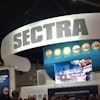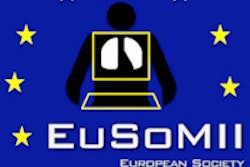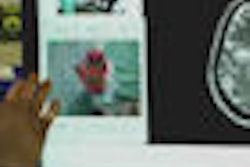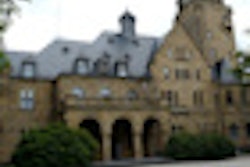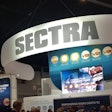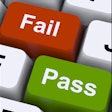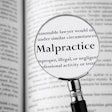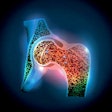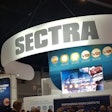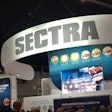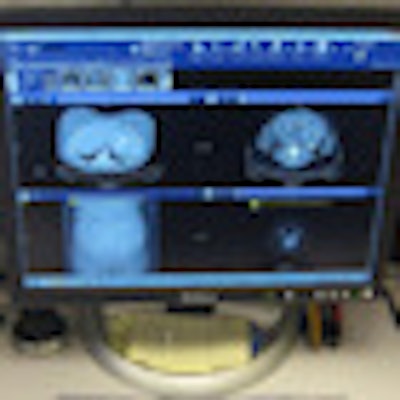
A keyboard and mouse are ubiquitous components of diagnostic imaging workstations. But after two decades, it's time to convert to so-called natural user interfaces, according to a presentation made at the 30th International EuroPACS meeting, held during last week's Computer Assisted Radiology and Surgery (CARS) congress in Pisa, Italy.
Cliff Edwards, a senior research engineer in health IT at McKesson Enterprise Medical Imaging in Richmond, British Columbia, balanced the perspectives of being both an academic researcher and a futuristic new product developer for a PACS vendor. He described research being undertaken to interface gesture interaction techniques and devices that might improve productivity, increase comfort, and reduce user fatigue at McKesson's PACS engineering facility in Canada.
"We know that radiologists want improvements over standard keyboard and mouse interactions with their PACS," Edwards noted. "My goal is to understand the interaction constraints that exist for radiologists sitting at a diagnostic workstation for hours. We are investigating newly available technology for natural user interfaces, as well as technology being used in consumer electronics, mobile devices, video games, or digital music controllers and instruments."
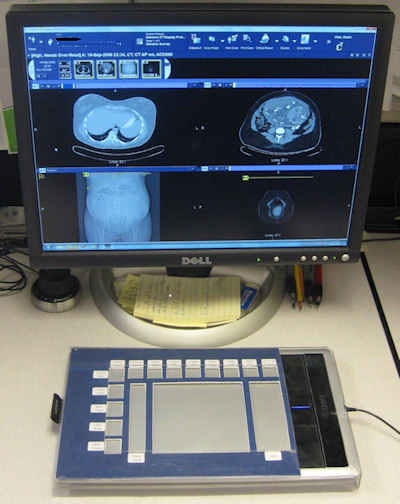 A multitouch graphics pad, adopted for use as a PACS workstation -- touch and gesture interface device with labeled virtual buttons to tap for keyboard shortcuts, plus finger slider regions for power scroll and zoom to either side of a central trackpad and gesture sensing area. Image courtesy of Cliff Edwards, McKesson Enterprise Medical Imaging.
A multitouch graphics pad, adopted for use as a PACS workstation -- touch and gesture interface device with labeled virtual buttons to tap for keyboard shortcuts, plus finger slider regions for power scroll and zoom to either side of a central trackpad and gesture sensing area. Image courtesy of Cliff Edwards, McKesson Enterprise Medical Imaging.He said that the widespread adoption of consumer mobile devices such as smartphones and tablets have demonstrated that powerful touch and gesture alternatives to mouse-driven graphical user interfaces exist. However, it isn't immediately obvious how to translate mobile-device style direct-display computer interaction to a PACS diagnostic workstation whose display monitors must sit vertically on a desk or table. Any touch or gesture interaction should happen with the arms in a comfortable resting position, but unlike many consumer devices, touching the display monitor is not appropriate.
Edwards is hoping that a gesture pad may offer a solution. This versatile multitouch sensing pad has software to map finger taps and gestures on defined regions of the pad into image review control operations. McKesson demonstrated the PACS GesturePad as an experimental work-in-progress at RSNA annual meetings. Many radiologists who saw a demonstration of the gesture pad were enthusiastic about it, and many expressed concern about the fatigue they feel in their fingers and hands using a mouse and keyboard all day. Edwards and colleagues are hoping to field-trial this prototype in a radiology department to get feedback about its performance in real-world conditions.
As currently configured, the gesture pad is placed adjacent to a keyboard where its controls can easily be reached by a hand. A paper template overlaid on the sensing service defines functional regions and provides a tactile sense of where fingers are touching, an important feature since a radiologist's eyes should be focused on the display monitors.
Its large central region supports a gesture-enabled mouse trackpad. Multifinger gestures, such as the two finger slide to scroll images are performed here, as well as three- and four-finger sliding gestures to control window/level, pan, and magnify. Regions of the pad programmed for discrete operations function like keyboard shortcuts. These "virtual buttons" are activated by a tap of the finger on a region.
The pad also supports regions on each side of the central trackpad area. These are dedicated to the most common interactive operations, such as fast scroll and zoom, and can be controlled with rapid finger motions.
Edwards said that diversity of hand styles of radiologists trying out the prototype identified strengths and weaknesses. It became apparent to him that the small sensing area limited the precise control needed for PACS operations, and that a more robust and improved resolution device is needed.
He also is evaluating other interaction techniques, including eye-gaze tracking. He's completed a prototype exploration using a new multitouch sensing mouse to simplify zoom and pan interactive PACS operations. And he is working with researchers at the University of British Columbia using depth sensing camera technology. While this latter application would not be appropriate for use in a radiology reading room, it could be very appropriate for use in an operating room, Edwards explained.
"My hope for my research is to stimulate ideas and awareness into alternatives to mouse and keyboard. I hope that radiologists will realize the options and potential for improvement and request changes. There is enough of a body of knowledge in other disciplines and domains that alternative techniques should be able to be transferred to the PACS workstation domain without having to do a lot of fundamental research," he added.
There will be design and engineering effort and costs to perfect some of these techniques, but it will be much less than if these new technologies weren't available.
"Radiologists need and want the improvements. Technology and techniques exist to make radiologists' working lives better. So now the issue is more about increasing demand so that the work can be done," concluded Edwards, who did not elaborate on any costs relating to revolutionizing the workstation.
